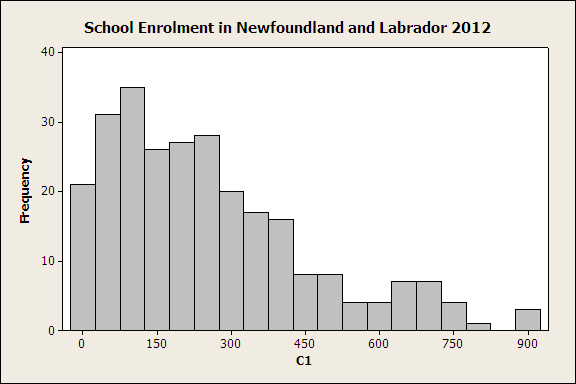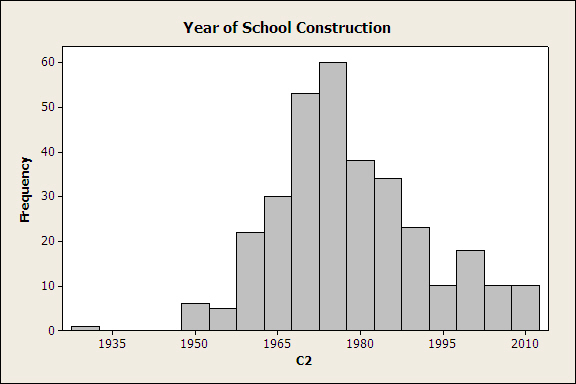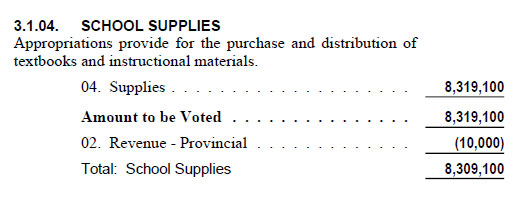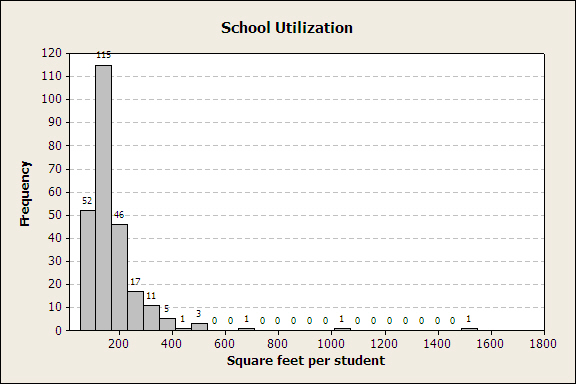- Home
- Deceptions
- Solar
- Thermal Audit
- Ventilation
- Sensors
- Governance
- Environment
- Reference
- Contact
- News
School Infrastructure and Enrollment in Newfoundland and Labrador
[Return to Policy Summary Page]
Teachers salaries represent about 60% of total K-12 costs, the rest is spent on building new schools, upgrading existing schools, paying utility bills, purchasing school books, contracting bus fleets and school board activities. Teachers can't be cut without impacting classroom sizes and the current budget for building maintenance is about half of what it needs to be. There are however, areas that could yield substantial savings.
The province used to have 600 schools, but due to population decline, consolidation of religious and public school systems and mold, most schools were closed. There are approximately 267 schools in operation in 2013.
There are two schools with 2 children each. In the graph below, the first bucket tells you that there are 20 schools with enrollments between 1 and 20 students. The point of the graph is that there are many schools that currently have very low enrollment. These schools were built for far larger populations in once thriving communities. This trend will continue.

The next chart shows schools by age of building. Buildings are aging just like the population is, many were built when the current adults were children. Most of the buildings built in the 1960's need significant upgrades. The most common problems are heating furnaces that are at end-of-life, roof and window leaks and obsolete electrical systems. Mold problems have been taken care of but there is still more asbestos abatement work to complete. Some schools don't have potable water and have to bring in bottled water because of boil orders. A typical upgrade costs $1 million. A million isn't much -- $100,000 in the 1970's or the price of two new bungalows in St. John's.

There are numerous schools with low student populations and eliminating them would not only force long commutes for children and staff (in some cases 120 km or more a day), but destroy one of the few remaining community assets. Solutions include updating buildings, making them multipurpose, insulating them to lower heating costs, using a mix of distance education and tutoring for the extreme cases (2 or 3 children for example) and in some cases letting the communities take over the infrastructure.
The following need to be implemented:
- A realistic (and much larger) budget for infrastructure that can get all 267 schools fixed up.
- All schools should be completely insulated to cut down on utility bills.
- Perform a complete asbestos audit and remove it all
- Organize a K-12 curriculum for home schooling and arrange for standardized assessments.
- Create provincial school textbooks in PDF format and format for easy viewing on tablet PCs. Millions are wasted every year on books from large publishers such as McGraw Hill. Many subjects, such as arithmetic do not change and do not require anything fancy - a reader from 1930 would suffice. Share with other provinces and states. Hold a competition and pay/reward teachers that are willing to write the 1st edition.
- When enrollment is 5 or less, the teacher could be a private tutor and these children could have an excellent education.
- Combine grades whenever enrollment is low. This is done now for two grades at a time.
- Perform life safety upgrades to school buildings (fire alarms, electrical service, mold and asbestos remediation, fixing leaks etc.) then hand over some under utilized schools to the community. The gym is needed for community events, some classrooms can be used for teaching, a teachers residence could be added where housing shortages exist. Only the community knows what is best for it and trying to centrally plan and micromanage in these situations is not productive. The school building may be the only public building in town suitable for events.
The existing inventory of old schools dates back to 1928 and most have considerable deferred maintenance. Some of this is to be blamed on the lack of building standards (e.g. window installation standards) and inadequate maintenance budgets. The solution is simple: Perform a complete engineering survey of all the buildings, prioritize by need, and then upgrade 20 of them a year for the next 10 years at which point, all major systems in all schools will be within 30 years of the last upgrade. Building envelop assessments (e.g. leaks) need to be about every 5 years, so this is about 25 inspections / repair projects a year on average. This would represent an approximate doubling of the school budget.
Full Day Kindergarten
Full day kindergarten should be implemented immediately.
School Supply Budgets

This $8M budget could be used to commission a set of K-12 text books written by Newfoundland authors, teachers, professors and then released into the public domain.
Some commercial speciality books would remain, especially the French curriculum which is low volume. New course materials would use a mix of technologies -- PDF documents to view on tablets, interactive programs which could be written/coded by university work term students, slide shows, tutorials on Youtube and videos that could be projected on the provinces interactive white boards.
For an example of excellent tutorials, have a look at the free, public service site Kahn Academy. Many of these tutorials are exceptionally good.
Material would be published on demand (printed) at schools when needed. Once the material was created, future budgets would be reduced to the levels required for paper, photocopy/printer supplies and reasonable fees to the authors for updates/corrections/supplements to material. Having $8M go into the local economy is vastly superior than having it go to multinational textbook publishing companies.
School Busing
As a policy, all schools should be within walking distance for the age group being served. Regional schools are a little cheaper to heat and you can save a few staff positions (e.g. you still only need one principal), but are terribly inefficient if you include the larger picture. For example, teachers spend thousands of dollars commuting to work, bus fleets are required to move students, the health benefits of walking are lost, road maintenance costs are increased, and the learning environment becomes more impersonal and institutional.
Busses aren't going away tomorrow, so at a minimum, they should have seat and shoulder belts, head restraints, and be operated by professional drivers with a commercial license (e.g. formal training for operation of large vehicles). An alternative would be to have a school bus driver training program and a special license endorsement.
School Closings
Schools closings are determined by the school boards, which formerly consisted of Eastern School District, Nova Central, Western, Labrador and Francophone. These will be consolidated into two boards later in 2013. No board wants to close a school, but as their budgets become inadequate (costs are always rising), they are forced to find something to close. An incentive exists because operating grants to run the closed school continue for a few years.
The Department of Education forces these closures indirectly by limiting funding, and like all things political, can override these decisions either by a phone call, or by increasing funding to the school boards.
There is no coherent policy on school infrastructure, so here is a proposal:
| School Utilization in Square feet / Student | Action |
| less than 300 square feet (about 250 schools) | Earmark $1 million per building to upgrade fire alarm, heating, electrical, repair anything rotting, seal abandoned water wells, fix all leaks and drainage problems, add insulation to walls and floors when missing, flash windows properly. The heating system upgrade should be heat pump based to minimize future operational costs. (these are all important things) |
| between 300 and 500 square feet (currently 15 schools) | Request proposals from the community to convert the school into a multi purpose building. The $1 million upgrade will then be modified to ensure modern gym and stage lighting and audio, add a few partition doors e.g.: Separate entrance to gym/theater and offices, door to close off classroom section etc. Install utility sub-metering so that light/heat costs can be fairly allocated. Community to set locally affordable rental fees for space and make a contribution to operation costs. Administration of community usage should be volunteer / non profit. |
| 500 square feet or more. (currently three schools) | Tactics here would depend on how many children are left. For 1 to 4 children, set up private tutoring and sell the school building. If it can't be sold, demolish it replant the site with trees. If a parent of a child in a remote location wishes to home school, support them with a home school curriculum and e-mail support for the parents. Parents could scan homework or progress tests to a teacher somewhere for feedback / guidance. For 5 or more children, make it K-12, combine grades and set up a high speed video link so that children can participate in classes at a larger school. For example, find the best science lecturer in the province and beam those lectures in live if say, Biology is not a speciality of the few teachers at the school. Ask the community for proposals to see if they can support a multi purpose building. They may have local tradesman that will work for free - with the government providing all construction materials as well as blueprints. This would cut upgrade costs in half and prevent outlandish costs per student.
|
The chart below shows how many schools fall in each utilization range. There is one school with 1500 square feet per child, one with 1050 square feet per child, three schools between 570 and 530, etc. The most common range is 110 to 170 square feet per child, and 115 schools are in that category.

Closure decisions should not be left up to school boards. It is the responsibility of the Department of Education.
Note to the communities with schools slated for closure: Try the following:
- Get together a group of people and find some trades people to help you. An electrician and carpenter and ideally an engineer. Organize a visit to the school and ask the staff which rooms are in use, and what areas could be used for other activities. The school staff is an asset.
- Leave room for full day kindergarten.
- Ask the department of transportation to e-mail you all the blueprints they have. These will be old scanned images that you can print on your computer. The architects name will be on the blueprint. Try contacting him for advice - he may be happy to help save the building he designed. You can verify the accuracy with a site visit since there may have been renovations or demolitions over the years. Use a colored pen to add annotations for changes needed. Perhaps, you want a separate gym entrance and locking partition so that the rest of the school can be closed when the gym is used for evening events, or a partition to separate a few classrooms that will become offices.
- Take pictures of the crawl space and of any areas that need modifications. All of this will enable local contractors to give you a realistic estimate of what they would bid on a job of this size.
- Find local organizations or businesses that are interested in using the space if it becomes available. Possibilities include creating an teachers apartment, a community theatre group that will put on several performance a year, host adult education at night, provide office space for a child psychologist or other profession that fits well with the age group.
- Promote the proposal on the web and social media. Display your blueprints, list the sponsors. Demand from your MHA that the school receive an immediate upgrade (electrical, heating, floor and attic insulation and asbestos removal). Point out that the community asset will utilized to xx percent.
- Calculate the extra miles of school bus and staff commuting that the school closure will cost.
- Let your board officials, MHA and Premier know that non compliance with reasonable requests will generate a swarm of bad publicity and cost political damage.
- Lead !
